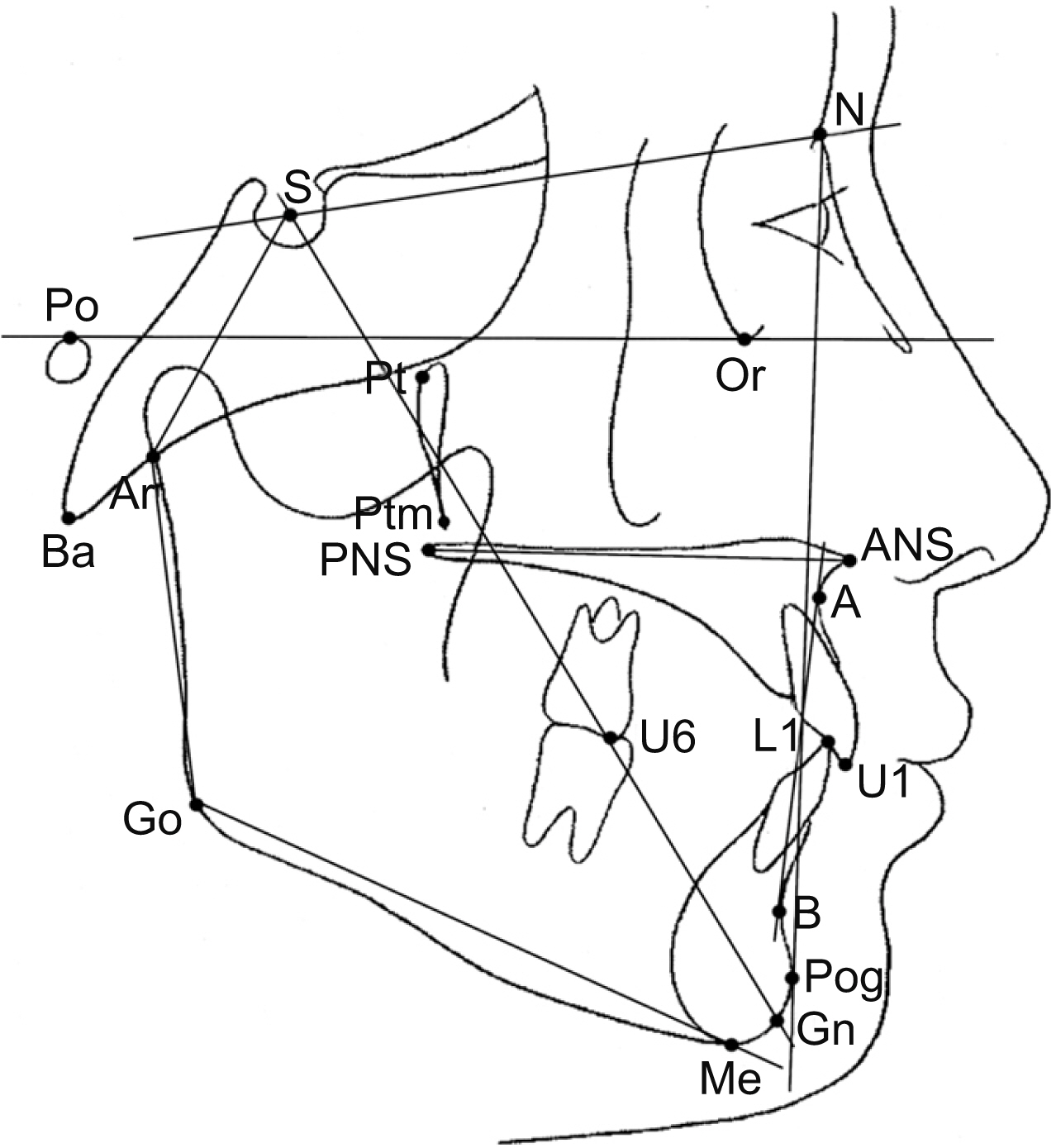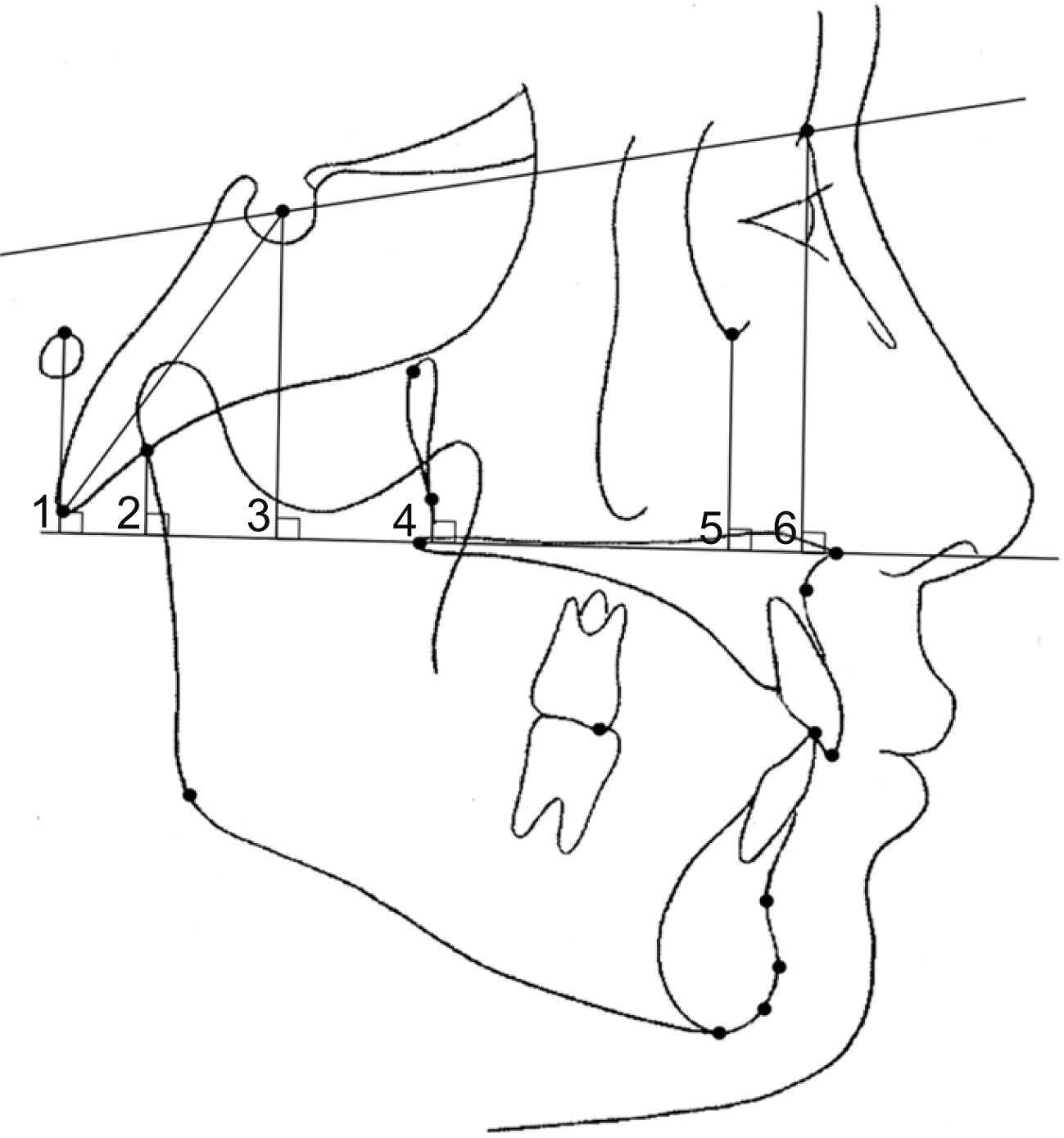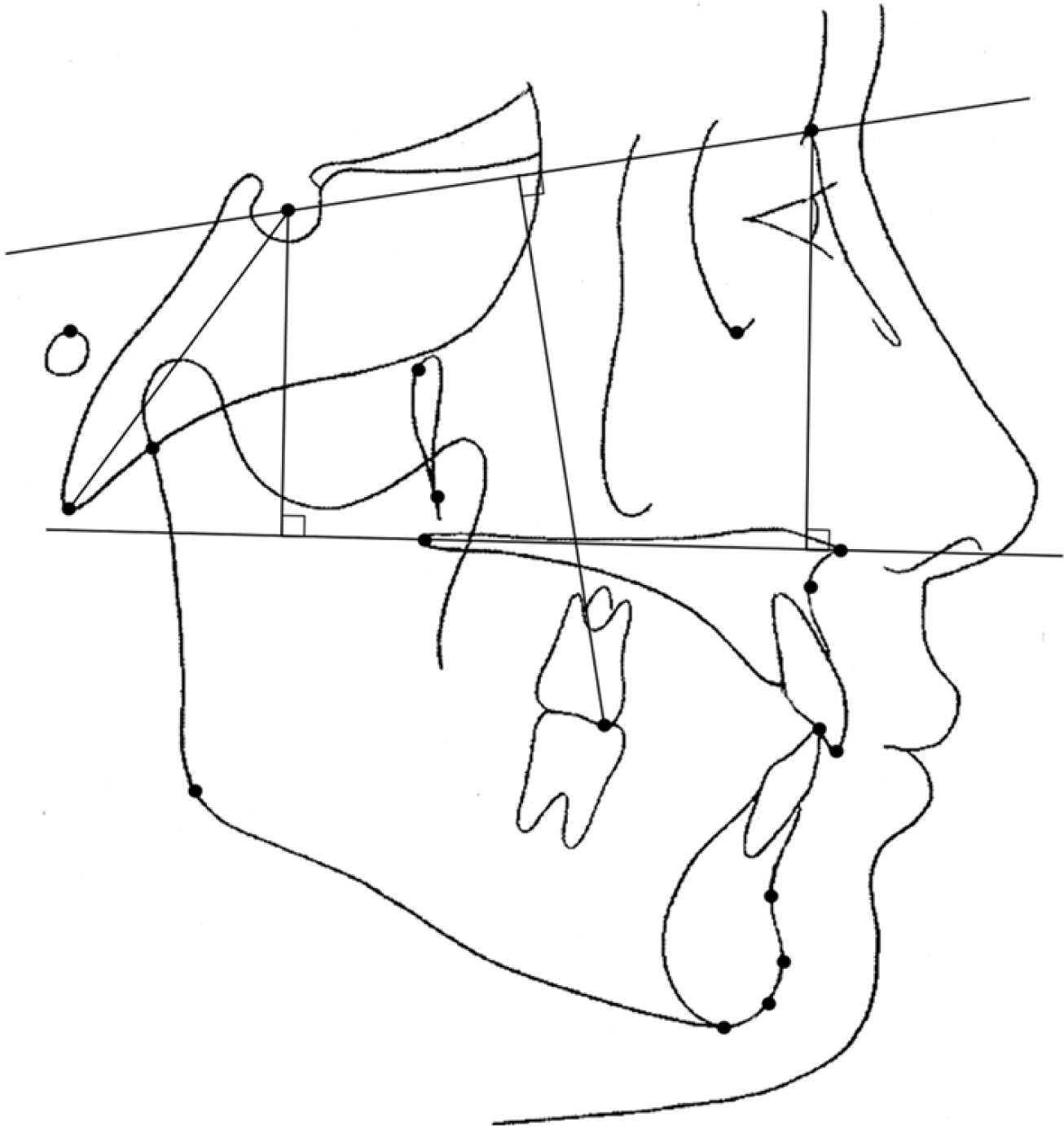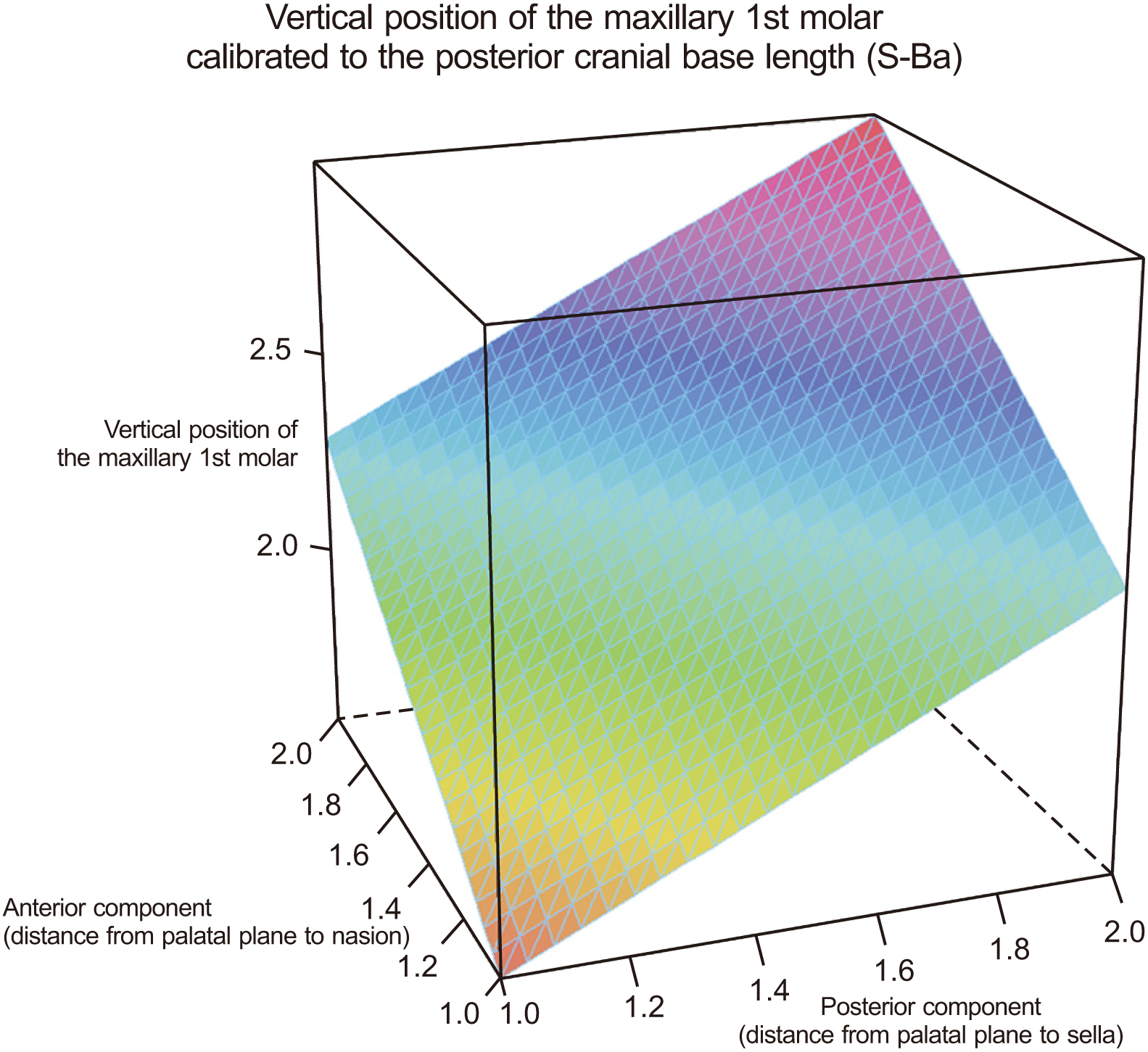Korean J Orthod.
2021 Jan;51(1):15-22. 10.4041/kjod.2021.51.1.15.
Relationship between vertical components of maxillary molar and craniofacial frame in normal occlusion: Cephalometric calibration on the vertical axis of coordinates
- Affiliations
-
- 1Department of Orthodontics, Seoul National University Dental Hospital, Seoul, Korea
- 2Department of Dentistry, School of Dentistry, Seoul National University, Seoul, Korea
- 3Department of Orthodontics, Dental Research Institute, School of Dentistry, Seoul National University, Seoul, Korea
- KMID: 2510614
- DOI: http://doi.org/10.4041/kjod.2021.51.1.15
Abstract
Objective
The aim of this study was to evaluate the correlation between the vertical position of maxillary first molar and vertical skeletal measurements in lateral cephalograms by using new linear measurements on the vertical axis of coordinates with calibration.
Methods
The vertical position of maxillary first molar (U6-SN), and the conventionally used variables (ConV) and the newly derived linear variables (NwLin) for vertical skeletal patterns were measured in the lateral cephalograms of 103 Korean adults with normal occlusions. Pearson correlation analyses and multiple linear regression analyses were performed with and without calibration using the anterior and posterior cranial base (ACB and PCB, respectively) lengths to identify variables related to U6-SN.
Results
The PCB-calibrated statistics showed the best power of explanation. ConV indicating skeletal hyperdivergency was significantly correlated with U6-SN. Six NwLin regarding the position of palatal plane were positively correlated with U6-SN. Each multiple linear regression analysis generated a two-variable model: sella and nasion to palatal plane. Among the three models, the PCBcalibrated model yielded highest adjusted R2 value, 0.880.
Conclusions
U6-SN could be determined by the vertical position of the maxilla, which could then be used to plan the amount of molar intrusion and estimate its clinical stability. Cephalometric calibration on the vertical axis of coordinates by using PCB for vertical linear measurements could strengthen the analysis itself.
Figure
Reference
-
1. Janson GR, Metaxas A, Woodside DG. 1994; Variation in maxillary and mandibular molar and incisor vertical dimension in 12-year-old subjects with excess, normal, and short lower anterior face height. Am J Orthod Dentofacial Orthop. 106:409–18. DOI: 10.1016/S0889-5406(94)70063-X. PMID: 7942657.2. Solow B. 1980; The dentoalveolar compensatory mechanism: background and clinical implications. Br J Orthod. 7:145–61. DOI: 10.1179/bjo.7.3.145. PMID: 6934010.3. Kim SJ, Kim KH, Yu HS, Baik HS. 2014; Dentoalveolar compensation according to skeletal discrepancy and overjet in skeletal Class III patients. Am J Orthod Dentofacial Orthop. 145:317–24. DOI: 10.1016/j.ajodo.2013.11.014. PMID: 24582023.4. Fishman LS. 1997; Individualized evaluation of facial form. Am J Orthod Dentofacial Orthop. 111:510–7. DOI: 10.1016/S0889-5406(97)70288-9. PMID: 9155810.5. Casko JS, Shepherd WB. 1984; Dental and skeletal variation within the range of normal. Angle Orthod. 54:5–17. DOI: 10.1043/0003-3219(1984)054<0005:DASVWT>2.0.CO;2. PMID: 6584051.6. Downs WB. 1948; Variations in facial relationships; their significance in treatment and prognosis. Am J Orthod. 34:812–40. DOI: 10.1016/0002-9416(48)90015-3.7. Kim JY, Lee SJ, Kim TW, Nahm DS, Chang YI. 2005; Classification of the skeletal variation in normal occlusion. Angle Orthod. 75:311–9. DOI: 10.1043/0003-3219(2005)75[311:COTSVI]2.0.CO;2. PMID: 15898366.8. Baek MS, Choi YJ, Yu HS, Lee KJ, Kwak J, Park YC. 2010; Long-term stability of anterior open-bite treatment by intrusion of maxillary posterior teeth. Am J Orthod Dentofacial Orthop. 138:396.e1–396.e9. DOI: 10.1016/j.ajodo.2010.04.023. PMID: 20889043.9. Solano-Hernández B, Antonarakis GS, Scolozzi P, Kiliaridis S. 2013; Combined orthodontic and orthognathic surgical treatment for the correction of skeletal anterior open-bite malocclusion: a systematic review on vertical stability. J Oral Maxillofac Surg. 71:98–109. DOI: 10.1016/j.joms.2012.03.016. PMID: 22695022.10. Scheffler NR, Proffit WR, Phillips C. 2014; Outcomes and stability in patients with anterior open bite and long anterior face height treated with temporary anchorage devices and a maxillary intrusion splint. Am J Orthod Dentofacial Orthop. 146:594–602. DOI: 10.1016/j.ajodo.2014.07.020. PMID: 25439210. PMCID: PMC4427344.11. Proffit WR, Sarver DM. Proffit WR, Fields HW, Larson BE, Sarver DM, editors. 2019. Combined surgical and orthodontic treatment. Contemporary orthodontics. 6th ed. Elsevier;Philadelphia: p. 657–709.12. Miyajima K, McNamara JA Jr, Kimura T, Murata S, Iizuka T. 1996; Craniofacial structure of Japanese and European-American adults with normal occlusions and well-balanced faces. Am J Orthod Dentofacial Orthop. 110:431–8. DOI: 10.1016/S0889-5406(96)70047-1. PMID: 8876496.13. Björk A. 1951; The nature of facial prognathism and its relation to normal occlusion of the teeth. Am J Orthod. 37:106–24. DOI: 10.1016/0002-9416(51)90024-3. PMID: 14810883.14. Wilhelm BM, Beck FM, Lidral AC, Vig KW. 2001; A comparison of cranial base growth in Class I and Class II skeletal patterns. Am J Orthod Dentofacial Orthop. 119:401–5. DOI: 10.1067/mod.2001.112872. PMID: 11298313.15. Dhopatkar A, Bhatia S, Rock P. 2002; An investigation into the relationship between the cranial base angle and malocclusion. Angle Orthod. 72:456–63. DOI: 10.1043/0003-3219(2002)072<0456:AIITRB>2.0.CO;2. PMID: 12401055.16. Rothstein T, Phan XL. 2001; Dental and facial skeletal characteristics and growth of females and males with Class II Division 1 malocclusion between the ages of 10 and 14 (revisited). Part II. Anteroposterior and vertical circumpubertal growth. Am J Orthod Dentofacial Orthop. 120:542–55. DOI: 10.1067/mod.2001.118628. PMID: 11709673.17. Hopkin GB, Houston WJ, James GA. 1968; The cranial base as an aetiological factor in malocclusion. Angle Orthod. 38:250–5. DOI: 10.1043/0003-3219(1968)038<0250:TCBAAA>2.0.CO;2. PMID: 5242886.18. Kerr WJ, Adams CP. 1988; Cranial base and jaw relationship. Am J Phys Anthropol. 77:213–20. DOI: 10.1002/ajpa.1330770209. PMID: 3207170.19. Bacon W, Eiller V, Hildwein M, Dubois G. 1992; The cranial base in subjects with dental and skeletal Class II. Eur J Orthod. 14:224–8. DOI: 10.1093/ejo/14.3.224. PMID: 1302466.20. Singh GD, McNamara JA Jr, Lozanoff S. 1997; Finite element analysis of the cranial base in subjects with Class III malocclusion. Br J Orthod. 24:103–12. DOI: 10.1093/ortho/24.2.103. PMID: 9218107.21. Andria LM, Leite LP, Prevatte TM, King LB. 2004; Correlation of the cranial base angle and its components with other dental/skeletal variables and treatment time. Angle Orthod. 74:361–6. DOI: 10.1043/0003-3219(2004)074<0361:COTCBA>2.0.CO;2. PMID: 15264648.22. Kerr WJ. 1993; Letters to the editor. The cranial base in subjects with dental and skeletal Class II. Eur J Orthod. 15:85.23. Fields HW, Proffit WR, Nixon WL, Phillips C, Stanek E. 1984; Facial pattern differences in long-faced children and adults. Am J Orthod. 85:217–23. DOI: 10.1016/0002-9416(84)90061-7. PMID: 6608274.24. Taibah SM, Feteih RM. 2007; Cephalometric features of anterior open bite. World J Orthod. 8:145–52. PMID: 17580508.25. Lopez-Gavito G, Wallen TR, Little RM, Joondeph DR. 1985; Anterior open-bite malocclusion: a longitudinal 10-year postretention evaluation of orthodontically treated patients. Am J Orthod. 87:175–86. DOI: 10.1016/0002-9416(85)90038-7. PMID: 3856391.26. Isaacson JR, Isaacson RJ, Speidel TM, Worms FW. 1971; Extreme variation in vertical facial growth and associated variation in skeletal and dental relations. Angle Orthod. 41:219–29. DOI: 10.1043/0003-3219(1971)041<0219:EVIVFG>2.0.CO;2. PMID: 5283670.27. Ceylan I, Eröz UB. 2001; The effects of overbite on the maxillary and mandibular morphology. Angle Orthod. 71:110–5. DOI: 10.1043/0003-3219(2001)071<0110:TEOOOT>2.0.CO;2. PMID: 11302586.28. Kim YH. 1974; Overbite depth indicator with particular reference to anterior open-bite. Am J Orthod. 65:586–611. DOI: 10.1016/0002-9416(74)90255-3. PMID: 4524490.29. Freudenthaler JW, Celar AG, Schneider B. 2000; Overbite depth and anteroposterior dysplasia indicators: the relationship between occlusal and skeletal patterns using the receiver operating characteristic (ROC) analysis. Eur J Orthod. 22:75–83. DOI: 10.1093/ejo/22.1.75. PMID: 10721248.
- Full Text Links
- Actions
-
Cited
- CITED
-
- Close
- Share
- Similar articles
-
- A study of vertical harmony of adult craniofacial skelton with normal occlution
- A comparative study about the position of upper and lower jaws, and first molars in normal occlusion and Angle's Class I,II,III malocclusions
- A cephalometric evalauation of anterior openbite malocclusions treated by multiloop edgewise archwire technique
- Positional relationship between the maxillary sinus floor and the apex of the maxillary first molar using cone beam computed tomograph
- The compensatory adaptation of anterior teeth according to the skeletal rolation





